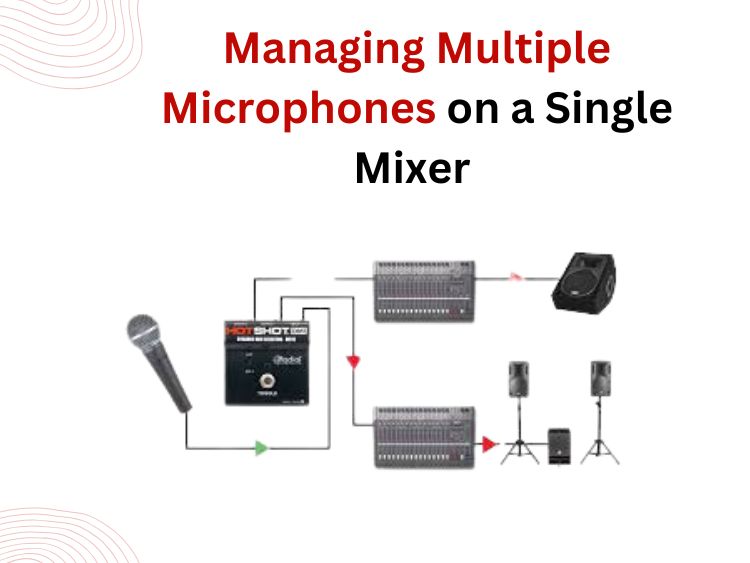Controlling several microphones on one mixer might appear to be a daunting task, particularly to less seasoned audio engineers, podcasters, event organizers, church staff, or band instructors. Nonetheless, any approach, no matter how packed, can be organized logically and made simple, uncluttered, and professional with the right planning.
In this blog, we will explain the strategies for effective multitasking on a single mixer to help you reduce the amount of feedback while maintaining optimal control over your sound system during your sessions.
If you want audio mixers for your home setting, then read: Best Audio Mixers for Home Studios in 2025.
Different Ways to Manage Microphones on a Single Mixer

Understand Your Mixer’s Layout and Capabilities
Familiarize yourself with your mixer’s channel strip before plugging anything in. Each microphone in use needs an input channel assigned to it.
Whether analog or digital, most mixers come with the following on each channel:
- Gain knob (input volume)
- EQ Section (high, mid, low)
- Aux Sends (for monitors or effects)
- Pan Control
- Fader or Level Control
Understanding how each of these controls work for different channels is very important. The more microphones you have, the more frequently you will be making adjustments to these controls for clarity and balance.
Correct Use of Cables and Microphones
As a rule of thumb, always use XLR cables for each microphone, as this is standard for professional audio setups. As a general guideline, don’t resort to using 1/4” instrument cables for microphones unless absolutely critical. They lack the quality and phantom power needed for condenser microphones.
Tweak the microphones to the specific setting:
- Use dynamic microphones for loud sources (vocals, drums, instruments).
- Use condenser microphones for quieter and more subtle sources (speech, acoustic guitars).
Every microphone has its unique characteristics and varying levels of sensitivity. Thus, consider each setup as a recipe and bring forth balance within your ingredients.
Keeping Everything Tidy and Well Arranged
It may seem unimportant for someone new to the area, but when handling multiple mics, especially in a live or fast-paced recording, organizing your channels and labeling cables is a breath of fresh air.
Label and color tape for easy identification of:
- What or who is connected to what channel.
- Phantom power requirements.
- Monitor or effect routing.
This advanced organization can prevent headache forming mistakes during setup or adjustments to level or EQ on the go.
Do you want best-rated audio mixers for live performances? Check here the top collection of 5 Core Audio Mixers.
Adjust Gain Levels Properly (Do not Skip This)
Many set ups skip the gain staging step which is where things go wrong.
- Get the person or instrument to speak/play into their mic.
- Increase the gain knob till the signal is strong enough but not clipping.
- Look at your level meters; for optimal performance, level peaks should be set between -6dB to -3dB for headroom.
In case the mic is too quiet, turning the fader instead of gain will introduce unwanted noise. Remember to always set gain first.
Employ EQ for Space Allocation
The frequencies of multiple microphones may clash and create a muddy sound. EQ can help provide clarity to every mic so that each has its own space.
- Cuts on low filters should be applied to vocals to get rid of any rumble or mic handling noise.
- Guitars that clash with the vocals should have their midregions scooped.
- Speech should be slightly boosted in the high regions during the upper range of speech.
Be delicate, subtle moves will yield tremendous results. It is better to cut than to boost too much.
Manipulate Panning for Stereo Separation
If you are working with stereo outputs, panning will significantly enhance clarity and definition.
- Pan away from center to stage mic position for better placement of sound.
- For monitoring playback in a mono mix, bring sounds to center.
This methodology averts clutter in space allowing each voice or instrument to reside clearly.
Final Thoughts
Balancing several microphones on one mixer is equally an artistic and scientific endeavor. Through the knowledge of signal flow, gain structure, EQ, and monitoring, you can create order from disorder. This is true whether you maintain a five-podcast guest system and full band rehearsals; controlling the mixer gives complete control of the audio environment. Want a top-quality audio mixer? Order 5 Core Audio Mixer 8 Channel DJ Equipment at best prices.
In a perfect combination of the right practices and some patience, you will be controlling multi mic setups with ease.


